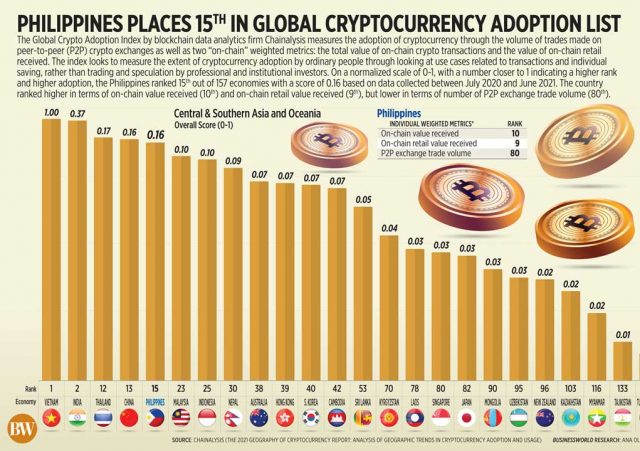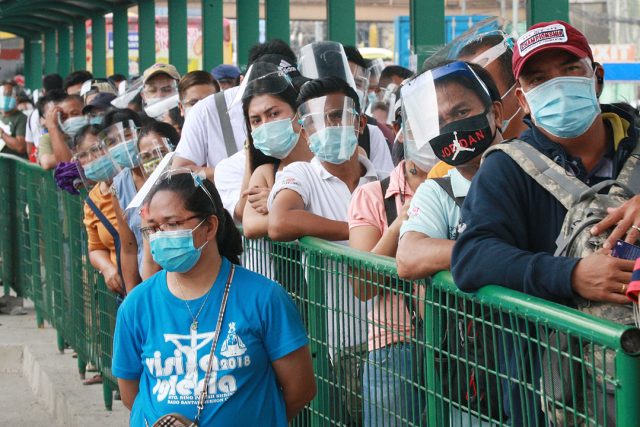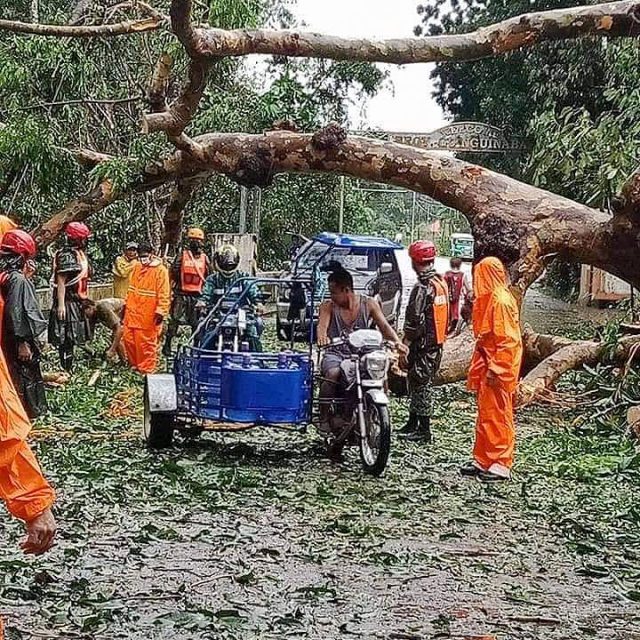Stocks rise on positive data, gradual reopening
PHILIPPINE shares continued to post gains on Monday on the back of positive economic data and eased restrictions in Metro Manila.
The Philippine Stock Exchange index (PSEi) inched up by 6.35 points or 0.08% to close at 7,219.81 on Monday, while the broader all shares index shed 17.88 points or 0.40% to 4,430.93.
“Upbeat OFW (overseas Filipino workers) remittances and [the] reopening of [the] economy [is] keeping [the] PSEi resilient,” First Metro Investment Corp. Head of Research Cristina S. Ulang said in a Viber message.
Data released by the Bangko Sentral ng Pilipinas last week showed cash remittances went up for the seventh consecutive month in August, rising 5.1% year on year to $2.609 billion from $2.483 billion.
The government also eased restrictions in Metro Manila to Alert Level 3, allowing more businesses to resume operations.
“Philippine shares were off to a lukewarm start as investors will be given a snapshot of US industrial production tonight and the housing market highlight on Tuesday,” Regina Capital Development Corp. Head of Sales Luis A. Limlingan said in a separate Viber message on Monday.
“Earnings season is also now in full swing in the US before the Philippines follows in a couple of weeks, and a number of big names are set to report in the next few days,” he added.
US stocks ended higher on Friday after Goldman Sachs became the latest big bank to report strong quarterly earnings, and Wall Street’s three major indexes posted gains for the week, Reuters reported.
Goldman Sachs Group shares jumped, giving the Dow its biggest boost, as a record wave of dealmaking activity drove a surge in the bank’s quarterly profit.
Results from the big financial institutions last week provided a strong start to third-quarter US earnings, though investors will still watch in coming weeks for signs of impacts from supply chain disruptions and higher costs, especially for energy.
Mr. Limlingan said “anticipation is for solid corporate earnings against concerns about inflation and the economy’s recovery.
Sectoral indices were split on Monday. Property went up by 47.02 points or 1.41% to 3,377.20; financials gained 11.09 points or 0.70% to finish at 1,584.96; and mining and oil rose 20.24 points or 0.18% to 10,748.17.
Meanwhile, services lost 22.94 points or 1.2% to 1,880.06; holding firms declined by 32.75 points or 0.46% to 7,048.31; and industrials went down by 24.97 points or 0.23% to end at 10,587.65.
Value turnover increased to P11.25 billion with 1.1 billion shares switching hands on Monday from the P10.56 billion with 1.22 billion issues traded on Friday.
Decliners beat advancers, 131 versus 67, as 42 names remained unchanged.
Net foreign buying more than tripled to P847.51 million from the P274.53 million logged on the previous trading day. — K.C.G. Valmonte with Reuters
Peso drops vs the dollar on weaker-than-expected China GDP growth
THE PESO weakened versus the greenback on Monday due to cautious sentiment as China’s growth came in slower than expected.
The local unit closed at P50.84 per dollar on Monday, weaker by 12.9 centavos from its P50.711 finish on Friday, based on data from the Bankers Association of the Philippines.
The peso opened Monday’s session at P50.73 per dollar. Its weakest showing was at P50.89, while its intraday best was at P50.72 against the greenback.
Dollars traded slipped to $829.49 million on Monday from $957.74 million on Friday.
The peso depreciated from its previous close after the release of data showing China logged weak economic growth in the third quarter.
China’s gross domestic product (GDP) grew by 4.9% in the July-September quarter from a year earlier, its weakest pace since the third quarter of 2020, Reuters reported on Monday.
The world’s second-largest economy is grappling with power shortages, supply bottlenecks, sporadic coronavirus outbreaks and debt problems in its property sector.
Meanwhile, a trader said the peso weakened on market preference for the dollar after an unexpectedly strong US retail sales report.
The US Commerce department reported on Friday that retail sales rose 0.7% in September following the 0.9% in August. Last month’s print was stronger than the 0.2% forecasted by economists polled by Reuters.
The US dollar headed back on Monday towards a one-year high hit last week as rising inflation expectations and higher bond yields boosted its appeal against its rivals, Reuters reported.
The dollar index rose 0.1% to 94.02, edging it back toward last week’s one-year high of 94.563 which was the highest level since September 2020.
For Tuesday, Mr. Ricafort gave a forecast range of P50.75 to P50.95, while the trader expects the local unit to move within P50.70 to P50.95. — LWTN with Reuters
Fewer than 7,000 cases posted for second day
By Kyle Aristophere T. Atienza, Reporter
THE DEPARTMENT of Health (DoH) reported fewer than 7,000 coronavirus infections for the second straight day on Monday after cases peaked in early September.
There were 6,943 coronavirus new cases, bringing the total to 2.73 million, it said in a bulletin. The death toll rose to 40,761 after 86 more patients died, while recoveries increased by 19,687 to 2.62 million.
There were 68,832 active cases, 79.7% of which were mild, 5.5% did not show symptoms, 4.5% were severe, 8.42% were moderate and 1.9% were critical.
The agency said 25 duplicates had been removed from the tally, 16 of which were reclassified as recoveries, while 30 recoveries were relisted as deaths. Two laboratories failed to submit data on Oct. 16.
“Nationally, our cases have been going down since our peak in early September,” Health Undersecretary Maria Rosario S. Vergeire told an online news briefing. Daily infections fell by 23% from a week earlier.
The Philippines had a daily average of 7,732 cases from Oct. 13 to 17, compared with 10,067 from a week earlier.
The country and most regions were at moderate risk from the virus, Ms. Vergeire said. But more than 70% of COVID-19 beds or intensive care units in several regions had been used, she added.
Meanwhile, Ms. Vergeire said 84.6% or 633 of 748 coronavirus infections tested on Oct. 16 were of the more contagious Delta variant, bringing the total to 4,431.
Three more Alpha variant infections and six Beta variant cases were detected in DoH’s latest genome sequence runs.
Ms. Vergeire said 88.46% or 15,168 of 17,147 samples sequenced as of Oct. 16 contained Sars-Cov-2 lineages. She added that 70.4% of the 15,168 samples were either Alpha, Beta or Delta variants.
The Delta variant has been detected in 17 regions of the country and all 17 local government units in Metro Manila, she said.
Of the 961 returning migrant Filipinos tested, 67% or 645 had tested positive for a coronavirus variant of concern, Ms. Vergeire said.
An inter-agency task force last week placed Metro Manila under Alert Level 3 from Oct. 16 to Oct. 30, allowing more nonessential businesses such as cinemas to reopen at reduced capacities.
The capital region’s seven-day average of new coronavirus cases have gone down by 27% or 533 cases, Ms. Vergeire said.
“As we safely reopen the economy, mobility will increase,” she said. “Maintaining the detection-to-isolation intervals at four days or further shortening this can counter its negative impact.”
Ms. Vergeire said the government should vaccinate more senior citizens and seriously ill people to ease the burden on hospitals and reduce deaths.
The Philippines, which scored poorly in a global index that measured the recovery of more than 100 countries from the coronavirus pandemic, is boosting its vaccination drive to reach its target of inoculating at least 50% of its adult population by yearend. The government aims to fully vaccinate 70% of the population by February.
The country on Friday started inoculating children aged 12 to 17 with health complications in eight hospitals in Metro Manila. Ms. Vergeire said 1,509 children have been vaccinated against the coronavirus as of Oct. 16.
She confirmed reports that four children had experienced side effects after getting vaccinated. One experienced high blood pressure, one had an allergic reaction, and two experienced stress-related reactions. “This is still being studied by our vaccination sites and our vaccine cluster.”
The vaccination of minors went smoothly because clearance from doctors and the consent of parents had been obtained in advance, she added.
Philippine President Rodrigo R. Duterte last week took responsibility for the shortage of coronavirus vaccines in the country early this year.
The president last month criticized rich countries for hoarding vaccines while poor countries struggled to secure shots for their people. He described vaccine hoarding as a shockingly “selfish act” that should be condemned.
Earlier this year, Mr. Duterte accused the European Union of holding up vaccine supplies from other countries, citing the economic bloc’s export rule that requires drugmakers to obtain permission first before shipping out coronavirus vaccines.
The tough-talking leader has repeatedly threatened to order the arrest of Filipinos who refuse to get vaccinated against the coronavirus.
Substitution now getting old as a political strategy, analysts say
By Russell Louis C. Ku and Alyssa Nicole O. Tan
POLITICAL parties risk losing votes if they use substitution as a strategy to buy time in choosing their presidential bets, according to analysts.
“They may succeed in hurdling legal obstacles, but I doubt they will gain the support of more voters,” Dennis C. Coronacion, who heads the University of Santo Tomas Political Science Department, said in a Viber message.
Filipinos might now be wary of substitution, which President Rodrigo R. Duterte used in the 2016 presidential race. His presidential run did not become official until the last minute.
Subsitution allows a political party to replace a member who filed a certificate of candidacy with a another member. Filing ended on Oct. 8 but substitution is allowed until mid-November.
“It would be unwise for the administration party or its allies to resort to it again,” Mr. Coronacion said.
Lakas-CMD Secretary-General Prospero A. Pichay, Jr. earlier said they fielded placeholders for president and vice president, hoping that Davao City Mayor and presidential daughter Sara Duterte-Carpio will change her mind and run for president.
The party no longer expected Ms. Carpio to run and was considering former Senator Ramon “Bong” B. Revilla, Jr. as its presidential bet.
Senator Ronald M. de la Rosa, who filed to run for president under the PDP-Laban party, has also said he was ready to give his slot to Ms. Carpio, who is running for reelection as Davao City mayor.
“Although this kind of political machination is to be expected from our political elites, their goal has always been to acquire power by any means possible,” Michael Henry Ll. Yusingco, a senior research fellow at the Ateneo de Manila University Policy Center, said in a Viber message. “Misusing legal mechanisms to their advantage is simply par for the course for them.”
Meanwhile, analysts said the coronavirus pandemic had made Filipinos more politically mature and could spur them to vote based on issues rather than personalities.
“Apathy is out of the picture,” Enrico V. Gloria, an International Relations assistant professor from the University of the Philippines Diliman, said in an e-mail. “Especially given how the pandemic was mismanaged, it is very clear to the average Juan that whoever we elect has a direct influence on the quality of life he’s able to enjoy.”
“A lot of people are beginning to realize that the current administration’s pandemic response is inadequate,” UST’s Mr. Coronacion said. “Health will definitely be on top of the voters’ selection criteria.”
Thirty-seven celebrities and 13 athletes are gunning for national and local positions next year. Filipinos have a record of voting for popular candidates who know nothing about governance.
As of Sept. 30, 63.7 million Filipinos have registered for the elections next year, according to the Commission on Elections. Voter turnout in 2016 was 81.95% or 44.5 million out of 54 million voters.
There seems to be a “hunger” for participation, Mr. Gloria said, citing “preposterously long queues” at registration sites.
Young voters would have a big impact on elections results next year, Mr. Coronacion said, adding that social media campaigns would become the name of the game.
“Content-generation in this medium, however, is more democratized and varied,” he said. “There is the challenge to filter legitimate content, but also the opportunity to capitalize on a digital grassroots pool of supporters who can more efficiently diversify the candidates’ clout and reach.”
Storm Maring toll: 40 reported deaths, 22 towns, cities under state of calamity
REPORTED deaths due to floods and landslides triggered by severe tropical storm Maring, with international name Kompasu, has reached 40 while 11 others were missing and five injured, based on the Oct. 18 report from the national disaster management agency.
Declarations of state of calamity have been issued in 22 localities, which would allow the release of local funds for disaster response. These are in Narra, Palawan; Dagupan City in Pangasinan; and the entire province of La Union with 19 towns and one city.
Of the total deaths reported, 23 have been confirmed while the rest are still under further validation, according to the National Disaster Risk Response and Management Council (NDRRMC).
The number of affected families stood at 158,510 composed of more than 626,000 people. These are in the regions of Ilocos, Cagayan Valley, Central Luzon, Calabarzon, Mimaropa, Cordillera, Western Visayas, and Caraga.
NDRRMC said of those affected, almost 50,000 people were displaced and still in evacuation centers or staying with relatives or friends.
More than 300 road sections and bridges were affected, but most of these were already passable as of Monday.
There were 7,268 houses damaged, with 321 totally destroyed.
Maring, the 13th typhoon in the country this year, entered on Oct. 7 as a tropical depression. It absorbed the remnants of a succeeding typhoon named Nando and intensified into a severe tropical storm, packing winds of up to 100 kilometers per hour (km/h) and gustiness of up to 125 km/h. It exited the Philippine area on Oct. 12. — Marifi S. Jara
Orani town expands PayMaya use for services, transactions
THE COASTAL town of Orani in Bataan has tapped digital payments firm PayMaya Philippines, Inc. for the delivery of social service programs, tax payments, and other transactions as it aims to become a “digital-first community.”
“At Orani, we are always finding ways to help our citizens and businesses thrive in the New Normal. This initiative with PayMaya will accelerate our thrust to promote digital transactions among our citizens,” said Mayor Efren E. Pascual, Jr. in a statement Monday from PayMaya.
Among the initial uses rolled out for PayMaya include the distribution of financial assistance to senior citizens, cash-aid for health services, scholarship for Grades 7-10 students, and allowances for barangay-level officials and other workers.
At the municipal hall, payment of taxes and other government fees can now be done through PayMaya QR or PayMaya One, the all-in-one Android-based payment device for any credit, debit, prepaid card, and other e-wallets.
The company said taxpayers will also soon have the option to pay via the local government’s website with PayMaya’s online payment gateway, PayMaya Checkout.
Merchants at the Orani Public Market and Orani Fish Port will also be equipped to accept payments via PayMaya QR.
“We cannot wait to create a digital-first community wherein our residents can transact seamlessly, safely, and conveniently with our government offices and enterprises through PayMaya’s digital platforms,” Mr. Pascual said.
Orani is classified as a first-class municipality with a population of more than 70,000 as of 2020.
“We are very excited at PayMaya to help accelerate Orani’s drive towards becoming a world-class and digitally-driven municipality,” Orlando B. Vea, company founder and chief executive officer, said.
PayMaya is a subsidiary of Voyager Innovations, Inc., the digital arm of PLDT, Inc.
Hastings Holdings, Inc., a unit of PLDT Beneficial Trust Fund subsidiary MediaQuest Holdings, Inc., has a majority stake in BusinessWorld through the Philippine Star Group, which it controls.
Transport dep’t eyeing to increase subsidy for PUVs amid fuel price hikes
THE TRANSPORTATION department on Monday said it is planning to increase the incentives it provides, through the service contracting program, to public utility vehicle (PUV) operators and drivers as a way to mitigate the impact of rising fuel prices.
In a statement, Transportation Secretary Arthur P. Tugade said the department has formally proposed to the Land Transportation Franchising and Regulatory Board (LTFRB) and the Department of Energy (DoE) that PUVs be given a uniform discount at gas stations nationwide.
Mr. Tugade also urged drivers and operators to take part in the government’s service contracting program where they will get paid on per kilometer basis to ensure that their operations remain “viable.”
“Sa binabayad na insentibo sa ilalim ng service contracting, kinonsidera po natin ang gastusin sa krudo (the incentive covers the fuel cost),” he noted.
“In consideration of the oil price hike, we are studying to increase the incentive for every kilometer,” Mr. Tugade added in Filipino.
In a phone message to BusinessWorld, Transportation Assistant Secretary Goddes Hope O. Libiran said the government currently pays public buses under the service contracting program P82.50 per kilometer. The subsidy per kilometer for jeepneys and other small modes of transportation under the program is P52.50.
Oil prices increased again this week by P1.8 per liter for gasoline, P1.5/L for diesel, and P1.3/L for kerosene. — Arjay L. Balinbin
Comelec expects 64M voters after Oct. 30 registration deadline
THE COMMISSION on Elections (Comelec) is expecting up to half a million more people who will enlist before the registration period deadline on Oct. 30, which will bring the number of voters in next year’s polls to 64 million.
During the Senate finance hearing on Monday, Comelec Chairman Sheriff M. Abas said the projected number of registrants for the month of Oct. is from 350,000 to 500,000.
Senator Maria Imelda Josefa “Imee” R. Marcos reiterated her plea for a two-week extension period for the registration of overseas Filipino voters, which ended earlier on Oct. 14.
“At least for the most populous or the consulates with the most Filipinos to allow our OFWs (overseas Filipino workers) to vote,” she said, adding that seafarers are among those who need the consideration.
Mr. Abas said the commission will take up the proposal on Wednesday. “I think it’s a good idea to cater only to those (areas)… where there are many who have yet to register.” — Alyssa Nicole O. Tan
Juaneza named NEA chief; Dizon quits BCDA post
FORMER Energy undersecretary Emmanuel P. Juaneza has been elected as the new administrator of the National Electrification Administration (NEA), the agency announced Monday.
In a statement, NEA said Mr. Juaneza was chosen during a special board meeting chaired by Energy Secretary Alfonso G. Cusi on Monday.
President Rodrigo R. Duterte had earlier endorsed Mr. Juaneza’s nomination to head the NEA.
“The job is challenging and I am enjoining everyone that we work together to execute the mandate of the NEA with focus on the total electrification of the remaining households across the nation,” Mr. Juaneza said.
His election comes around two months after Mr. Duterte dismissed former NEA administrator Edgardo R. Masongsong from service due to alleged corruption.
DIZON
Meanwhile, an official of the Bases Conversion and Development Authority (BCDA) said Vivencio B. Dizon has resigned from the agency’s top post.
“The resignation letter of president Vince Dizon to the President (Rodrigo R. Duterte) has an effectivity date of his resignation on Oct. 15,” BCDA Executive Vice President Aileen Anunciacion R. Zosa told the Senate committee budget hearing on Monday.
Ms. Zosa said Mr. Dizon, who was also appointed last year to lead the country’s coronavirus testing program, intends to help with “the anti-COVID efforts of the government.” — Angelica Y. Yang and Alyssa Nicole O. Tan
Former SolGen throws support to Robredo
FORMER solicitor general Florin “Pilo” T. Hilbay has resigned from the Aksyon Demokratiko party of presidential candidate and Manila Mayor Francisco “Isko” M. Domagoso to endorse the presidential run of Vice President Maria Leonor “Leni” G. Robredo.
In a statement posted on his social media accounts on Monday, Mr. Hilbay said he is leaving the party “out of ethical considerations” and because he believes Ms. Robredo “is a much better candidate in this most crucial of elections.”
Mr. Hilbay was solicitor general from 2014 to 2016 during the term of the late President Benigno S.C. Aquino III.
In another election-related development, senatorial candidate Rafael “Raffy” T. Tulfo said in an ANC interview Monday that he would push for legislation that would protect laborers such as banning contractualization and a “wage theft” bill that would penalize employers who fail to follow the minimum wage.
The broadcaster, who is running as an independent next year, is a top pick among senatorial candidates based on surveys conducted by Pulse Asia Research, Inc. and Social Weather Stations. — Bianca Angelica D. Añago and Russell Louis C. Ku














